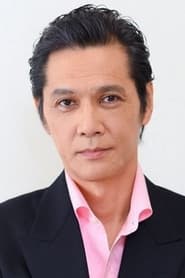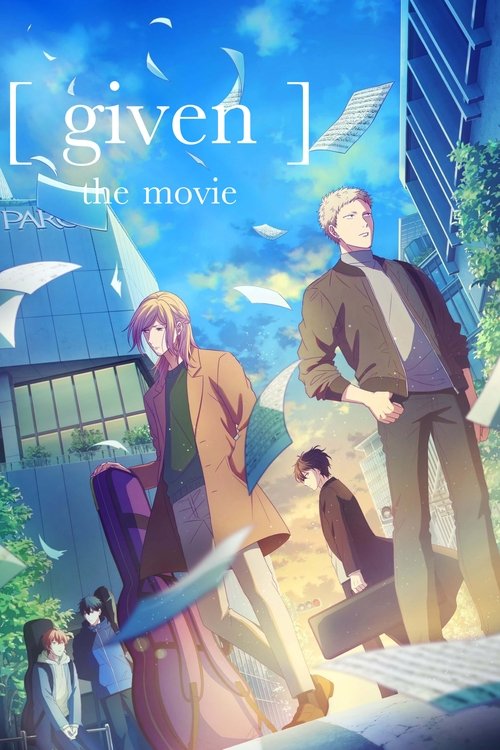
Ask Your Own Question
What is the plot?
The film opens with Satomi Oka standing before a cluster of third-year students in a junior high school gymnasium, baton in hand, directing the choir he has led through his final term. Satomi moves with practiced calm as the group sings; he checks posture, lifts his arm for an entrance, narrows his eyes to bring a section in on time. The scene concentrates on the mechanics of the performance: Satomi cuing dynamics, smoothing a rough breath in a soprano line, signaling a piano passage. After the concert ends, parents clap and students disperse. Satomi remains on the stage for a moment, gathering sheet music into a black folder, his expression a mixture of satisfaction and the quiet reserve of someone approaching a transition.
Kyouji Narita watches the performance from the gym's back row. He is introduced visually as a yakuza lieutenant: dark suit, visible tattoos at his wrists when he reaches for a cigarette, a heavy face that relaxes as he listens. Kyouji steps forward after the hall clears and approaches Satomi. He asks Satomi, directly and without ceremony, whether he can teach him to sing. Kyouji explains that his boss holds an annual karaoke competition and that he wants to prepare in advance. Satomi registers the request with surprise and hesitance; he is still a student, days away from graduation, and he is not a professional vocal coach. Kyouji insists politely but firmly, citing the importance of the event to his organization. Satomi contemplates for a beat and agrees to help him practice.
The narrative follows the pair into a series of coaching sessions that trace the development of their acquaintance. Satomi conducts the first meeting at a small karaoke box after school hours, carrying music scores and a metronome. He tells Kyouji to sing a short scale and listens to the roughness in Kyouji's pitch. Satomi corrects breathing, placing a hand near Kyouji's diaphragm to demonstrate support. He asks Kyouji to loosen his jaw, to think of vowels as tools rather than expressions of toughness. Kyouji tries the exercises awkwardly at first; he stumbles over legato lines and pushes his voice on the louder passages. Satomi notates the problems in a small notebook, marking dynamics and suggesting repertoire. Kyouji, unused to instruction, responds to correction with a quick, brusque laugh and then with quiet focus. He repeats a phrase until Satomi taps the beat in time and nods.
They schedule regular practices. Satomi conducts a session in the school's music classroom where he uses the piano to show chord changes and to practice transitions. He demonstrates rhythm patterns and then has Kyouji clap and sing in time. Kyouji fumbles at rhythm but compensates with feeling. Satomi insists on exercises: scales, octave jumps, controlled exhalations. In another session, Satomi brings Kyouji into a community center rehearsal hall to practice projecting without strain. Satomi stands near the far wall and asks Kyouji to sing toward a distant corner to learn resonance. Kyouji grows red-faced but succeeds after a few tries. Satomi corrects his diction again, writing down vowel modifications and recommending phrasing to suit Kyouji's timbre.
The film stages small moments that reveal both men's backgrounds and motivations without expository monologue. On the way to a practice, Satomi walks past lockers and a poster announcing his upcoming graduation recital; he pauses to look at it, and Kyouji notices. Satomi admits, in clipped language, that this performance is his last as a junior high choir leader. Kyouji responds with a rare personal remark: he says that he was impressed by Satomi's control and the way he commanded the room despite his youth. The conversation remains pragmatic; both men avoid deep confessions, but their exchange softens the distance between them. In a later scene, Kyouji arrives at a session with a small bouquet wrapped in cellophane. He apologizes awkwardly for bringing flowers to a student, then hands them to Satomi as thanks for the instruction. Satomi accepts them with a small, startled smile.
The training progresses into song selection and performance interpretation. Satomi listens through Kyouji's preferred tunes on a phone, nods at certain choices, and rejects others that would strain the lieutenant's voice. He suggests material that fits Kyouji's lower tessitura and advises on tempo adjustments to avoid breathless phrasing. Kyouji chooses a song that he declares suitable for his boss's tastes; Satomi experiments with keys and selects one that allows Kyouji to approach high notes without forcing. They rehearse the song in fragments, then in sections, then in full runs. Satomi stops Kyouji at a dramatic moment, taps the metronome to slow the tempo, and demonstrates a softer onset on a phrase. Kyouji imitates the technique and discovers a modulation of tone that surprises him. He repeats the phrase several times, improving with each iteration.
Small conflicts arise during rehearsals but remain personal and contained. Kyouji's impatience leads him to push louder than necessary; Satomi scolds him once, not harshly but with an authoritative firmness that recalls his role with the choir. Kyouji bristles and leaves the room for a few minutes, smoking outside, then returns and apologizes in a few measured words. Satomi admits he has little experience teaching someone from Kyouji's world and asks for patience. Kyouji replies that he will follow instructions precisely. The two men negotiate their interaction patterns: Satomi will provide technical guidance, Kyouji will show up punctually and practice between sessions. The film records these adjustments through concise scenes rather than extended speeches.
As they spend time together, a bond forms that is practical and companionable. Satomi corrects Kyouji's posture before a particularly resonant phrase; Kyouji brings Satomi a pizza after a late-night run-through when Satomi has stayed to mark scores. They sit side by side in a karaoke room, sharing food while listening to recordings of professional singers for phrasing ideas. Satomi arranges vocal exercises into a short routine for Kyouji to practice alone: a warm-up, breath control, and a set of runs. Kyouji, who rarely finds himself in situations that require patience, adheres to the routine with methodical diligence.
The film includes a scene where Kyouji visits his yakuza office and speaks briefly with his boss about the upcoming karaoke competition. The boss mentions tradition and the importance of appearance at the event; Kyouji says he has enlisted outside help and gives a laconic description of Satomi. The boss asks whether Kyouji is serious; Kyouji replies that he wants to do well. The boss nods and accepts Kyouji's effort but emphasizes the competitive nature of the gathering. This scene provides a concrete reminder of the stakes for Kyouji within his organization.
Rehearsals continue with a series of concrete technical improvements. Satomi teaches Kyouji how to manage a sustained note through timed inhalations and controlled exhalations; they mark bars of breathing on the sheet music and practice with the metronome. Kyouji works on lowering his larynx for a rounder tone on mid-range notes, and Satomi demonstrates tongue position to clarify consonants. Satomi records Kyouji on his phone and plays the take back; they listen together and make adjustments. After a particularly productive session, Kyouji pauses in the doorway, removes his jacket, and thanks Satomi in a way that is spare but unmistakable. Satomi tucks a pencil behind his ear and says, simply, "Good work."
The film shows no violent confrontations. Kyouji's life as a yakuza is present in visual details--tattoos, sharp suits, the deference he receives at certain locales--but the narrative concentrates on the quotidian mechanics of learning to sing. There are no attacks or criminal actions depicted; interactions with other members of Kyouji's organization are perfunctory and focused on the karaoke event logistics. The film makes no use of weapons or physical violence, and no character dies.
Approaching the date of the karaoke competition, tension in the story shifts to performance nerves. Kyouji experiences a moment of doubt on the eve of the event: he stands in front of a mirror in his apartment, his face hard, and practices the opening lines. He falters on a high note and sinks into a chair, running a hand through his hair. Satomi calls and suggests a short warm-up routine over the phone; Kyouji follows Satomi's instructions and regains steadiness. The scene shows Kyouji's reliance on the technical scaffolding Satomi has provided rather than on bravado.
On the day of the competition, the film moves to the venue where Kyouji's gang assembles. Members file into the hall; the boss presides from a seat of authority. Kyouji stands off to the side in a tailored suit, his expression concentrated. Satomi comes to the venue as well; he watches from a discreet distance in the back or a shadowed corridor, holding his score folder. The pair exchange a short look before Kyouji goes on stage. The film presents the performance itself in direct detail: Kyouji steps up to the microphone, places his hand lightly on the stand, and breathes. He begins the song with the phrasing they practiced. Satomi watches Kyouji execute the opening lines with controlled breath and clear vowel placement. Mid-song, Kyouji negotiates a transition to a bridge that previously gave him trouble; he sustains a phrase over two measures without visible strain. The boss, seated in the front row, listens impassively but then nods once as Kyouji reaches a particularly expressive passage. Other gang members clap along out of habit or encouragement. The camera focuses on Kyouji's face: concentration, then a fleeting trace of satisfaction as applause follows the final chord.
After Kyouji's performance, the film shows him returning to his seat. He exchanges a brief, almost private smile with Satomi across the room. The boss offers a curt word to Kyouji--approval rendered in a few economical phrases--and Kyouji bows. Satomi approaches Kyouji backstage or in the venue's corridor and offers a concise assessment: he praises Kyouji's control and commends the work put into the phrasing. Kyouji thanks Satomi with a modest, direct comment about how the techniques made the song manageable. They stand together for a short time in the aftermath of the performance; other members circulate and the event continues, but the film lingers on their shared quiet.
The story proceeds into its concluding moments with Satomi's final graduation-related obligations resolving. Satomi participates in his last school ceremony; he wears the typical attire and exchanges packaged courtesies with teachers and classmates. He collects his school-related belongings and departs the campus, folder under his arm. Kyouji continues his role within the organization; the film shows him back in his office or standing before the boss, continuing his duties. The pair maintain contact: Satomi and Kyouji meet for a casual drink or a short practice that now feels more like a meeting between acquaintances than a teacher and a pupil. They do not enact a dramatic rupture or sweeping life-change; instead, their relationship remains a discrete, ongoing connection.
The final scene foregrounds a quiet, concrete resolution. Satomi and Kyouji meet one last time within the film's frame--Satomi in sensible shoes and a neat jacket, Kyouji in a sharply tailored suit. They stand in a modest public place, perhaps outside a karaoke establishment or near the school gate where their relationship began. They exchange a brief, precise conversation: Satomi asks how the boss received the performance; Kyouji replies that the boss was satisfied. Satomi remarks that Kyouji sang well. They part with a handshake or a light, mutual nod, not theatrical but definitive. Satomi moves away toward his next chapter--his steps measured as he walks down a street--and Kyouji turns back toward his car or his office, re-entering the life he inhabits. The film closes on this image of separation and continuation: both men leave the frame in different directions, their lives not merged but connected through the practical, skill-based work they shared.
Throughout the film, no characters die and no physical fights occur. Conflicts remain personal and revolve around technique, nerves, and the social distance between a student and a yakuza lieutenant. The narrative never stages violent resolutions; instead, it records a sequence of rehearsals, adjustments, performances, and small acts of courtesy that produce a durable, if unconventional, friendship. The story ends with the last publicities on screen: the venue empties, Satomi's graduation is complete, and Kyouji resumes his responsibilities--each man returning to his role while both carry the consequences of the lessons they exchanged. The final frame leaves them separated in space but linked by the shared memory of a song learned together.
What is the ending?
At the end of Let's Go Karaoke! (2024), Satomi Oka, the high school choir leader whose voice is changing due to puberty, performs his final choral piece while also helping Kyouji Narita, a yakuza lieutenant, prepare for a karaoke contest. The story concludes with Satomi finding a way to express care and support to both Kyouji and another character named Wada, symbolizing his acceptance of change and connection despite uncertain futures for all involved.
The ending unfolds in a series of scenes that highlight the emotional and narrative resolutions for the main characters:
-
Satomi's Final Choir Performance: As puberty affects Satomi's falsetto voice, he faces the challenge of his last choir performance. This event is significant because it marks the end of his time as the choir's head and the loss of his signature singing voice. The scene is portrayed with a focus on Satomi's internal struggle and acceptance of this inevitable change.
-
Kyouji's Karaoke Contest Preparation: Parallel to Satomi's choir finale, Kyouji Narita is preparing for the yakuza boss's annual karaoke contest, where the stakes are high--losing means receiving a tattoo from the boss. Kyouji, who initially forced Satomi into coaching him, has grown through their interactions. The preparation scenes show Kyouji's determination and the bond formed with Satomi.
-
The Karaoke Contest and Its Outcome: The contest itself is a pivotal moment. While Kyouji's yakuza career is implied to be heading toward a difficult future, his participation in the contest and the support from Satomi represent a personal victory. The film does not depict a triumphant win but rather focuses on the characters' growth and mutual respect.
-
Satomi's Gesture of Love and Support: In the touching finale, Satomi assumes a role that allows him to give meaningful signs of affection and care to both Kyouji and Wada, another character connected to the story. This act is symbolic, reflecting the theme of love as giving something valuable to others, even if it is difficult or unwanted by oneself.
-
Character Fates: Satomi moves forward, accepting the changes in his voice and life, while Kyouji faces an uncertain future in the yakuza world but gains personal growth through his relationship with Satomi. Wada's role is less detailed but is part of the emotional closure Satomi provides.
The ending emphasizes themes of change, acceptance, and the bonds formed between people from very different worlds. It balances the bittersweet reality of growing up and facing uncertain futures with moments of warmth and connection between the characters.
Is there a post-credit scene?
Yes, the movie Let's Go Karaoke! (2024) features a post-credit scene. This scene is described as short but satisfying and occurs after the end credits, so viewers are advised to stay seated until it appears. One review highlights that the post-credit scene includes a close look at a tattoo on the "sweetheart yakuza" character, which adds a charming detail that viewers are encouraged to notice and enjoy. The scene is considered a notable and enjoyable extra moment that complements the film's heartwarming and comedic tone.
How does Kyouji Narita, the yakuza, initially approach Satomi Oka?
Kyouji Narita, a yakuza, initially approaches Satomi Oka after hearing him sing beautifully in a contest. He decides to strong-arm Satomi into becoming his singing teacher, though their relationship evolves over time.
What motivates Satomi to continue teaching Kyouji despite the initial reluctance?
Satomi is motivated to continue teaching Kyouji as they find common ground and develop an unlikely friendship. This bond helps Satomi navigate his own challenges, such as dealing with the onset of puberty affecting his singing voice.
How does Kyouji's involvement in the yakuza impact his relationship with Satomi?
Kyouji's involvement in the yakuza creates a contrast between his tough exterior and his desire to sing, which Satomi helps him with. This juxtaposition highlights the complexities of Kyouji's character and adds depth to their friendship.
What role does Ms. Morimoto play in the story?
Ms. Morimoto introduces the concept of 'love' as a significant factor in the choir's performance, which is dismissed by some characters. Her statement adds a layer of introspection about the meaning of love and its impact on relationships.
How does the karaoke competition influence the plot and characters?
The karaoke competition serves as a pivotal event where Kyouji's passion for singing is showcased, and his relationship with Satomi is further developed. It highlights the absurdity of yakuza members taking karaoke seriously, adding comedic elements to the story.
Is this family friendly?
The movie Let's Go Karaoke! (2024) is generally considered a family-friendly comedy with heartwarming and funny moments, suitable for a broad audience including children, though it is not specifically targeted at very young kids.
However, there are a few potentially objectionable or upsetting aspects for children or sensitive viewers:
- The story involves a middle-aged yakuza (Japanese gangster) man interacting closely with a 12-year-old choir boy, which some viewers might find uncomfortable or sensitive due to the age difference and yakuza context, though the film treats their relationship with respect and warmth without explicit content.
- There is mild language used in some audience reactions and reviews, but the film itself does not appear to contain strong profanity or graphic content.
- Some scenes include yakuza-related themes and humor, which might be confusing or unsettling for very young children unfamiliar with such cultural elements, but these are presented in a light, comedic manner rather than violent or threatening.
- The film features some absurd and surreal humor, which might be puzzling or off-putting to sensitive viewers who prefer straightforward storytelling.
- There is a karaoke scene with off-key singing that is played for laughs, which is harmless but might be annoying to some.
No reports indicate any graphic violence, sexual content, or intense scenes that would make it inappropriate for family viewing, but parents might want to consider the yakuza theme and the age-difference dynamic when deciding suitability for younger children. Overall, it is a gentle comedy-drama with a lot of heart and no major objectionable content.


































